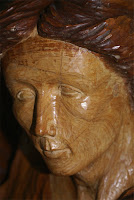One of the most colorful events of autumn I have ever experienced is a cranberry harvest, the time when the bogs are flooded and the berries separated from the scrubby bushes they grew on. The berries rise to the top of the water in an explosion of color that rivals the foliage surrounding the bogs.
The best place I have found to marvel at the riot of crimson is Carver, Massachusetts, a town settled by liberated slaves, and the best time for observing the harvest from the dry shoreline is Columbus Day weekend.
First the bog is flooded by a system of locks and dams.
Then a contraption that looks like a giant tricycle is run through the bog, releasing the berries from the bushes where they have been growing all summer.
At first there are only a few berries that slowly float to the top as the harvester steers through the bog.
As the labor continues, more and more berries appear.
Slowly the flooded bog looks less like a pond and more like an artist's palate.
The bog changes right before your eyes.
Who ever thought that cranberries are simply red? In fact they are crimson, pink, white, and every shade of red in between.
As you watch the palate evolve before your eyes, slight currents in the water flow through the berries making pictures that move.
Performance art in nature!
Click on any of the pictures for a larger view, and you can almost see the picture change before your eyes.

































